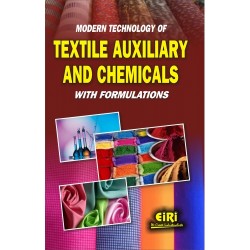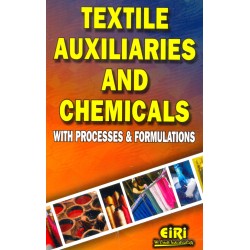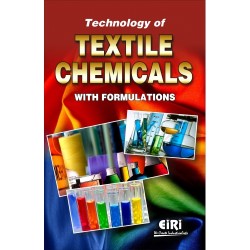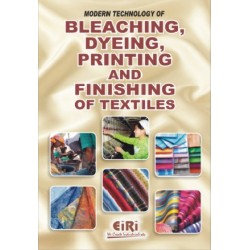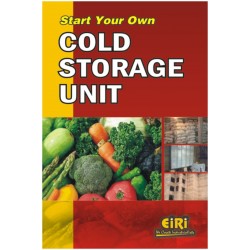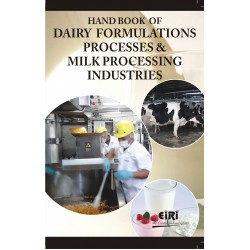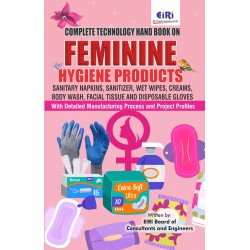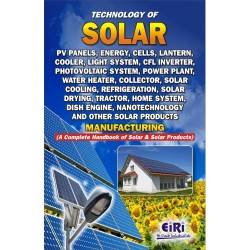Handbook textile processing chemicals, enzymes, dye fixing agents and other finishes with project profiles
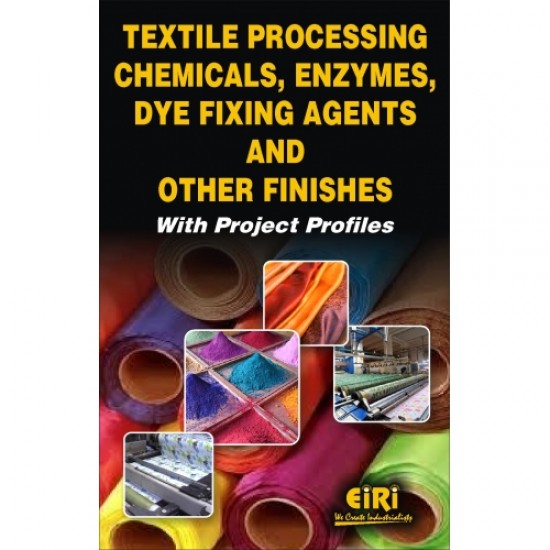
- More than 40 years of experience
- Managed by expert industrial consultants
- ISO 9001-2015 Certified
- Registered under MSME, UAM No: DL01E0012000
- 24/5 Research Support
Get your quesries resolved from an industry expert. Ask your queries before report or book purchase. - Custom Research Service
Speak to the our consultant to design an exclusive study to serve your research needs. - Quality Assurance
All reports are prepared by highly qualified consultants & verified by a panel of experts. - Information Security
Your personal & confidential information is safe & secure.
The book Textile Processing Chemicals, Enzymes, Dye Fixing Agents and Other Finishes with Project Profiles covers Enzymes used in Textile Processing, Enzymatic Bioprocessing, Antibacterial Agents, Textile Fibres Processing Enzymes, Fabric Finishing, Modification, Finishes, Soil Release Finishes of Fabrics, Flame Retardant Finishes, Thermal and Sorption Technology, Volatile Phosphorus, Chelating Agents, Dye fixing Agents, Anti static Agent with Spin Finish, Other important Finishes, Plant Economics of Acrylic Copolymer Emulsion, Plant Economics of Anti foaming Agents (Silicone based) for Distillery, Sugar Industry, Paper Plant etc. Plant Economics of Cationic Softener, Plant Economics of Chelated Zinc (ZNEDTA)12%, Plant Economics of Chelated Zinc EDTA & Chelated Copper EDTA, Plant Economics of Dye Fixing Agent (Low formaldehyde for Pigment Printing Like Acrafix ML), Plant Economics of Dye Fixing Agents (Non Formaldehyde Dyefixing Agent For Direct/Reactive Printing Like Tinofix FRD OF M/S CIBA GAIGY), Plant Economics of Dye Levelling Agent, Plant Economics of Enzyme Used for Denim Cloth and Garment Washing , Plant Economics of Enzymes Bio Technology based , Plant Economics of Non ionic Surfacetants Wetting Agents, Plant Economics of Silicone Emulsion for Textile, Plant Economics of Sizing Softener (Silk Sizing Liquid Water Soluble), Plant Economics of Textile & Finishing Agents, Plant Economics of Textile Printing Paste (GUM).
TEXTILE PROCESSING CHEMICALS, ENZYMES, DYE FIXING AGENTS AND OTHER FINISHES WITH PROJECT PROFILES
- Enzymes used in Textile Processing
- Enzymes as proteins
- Biocatalyst Enzymes
- Nomenclature
- Activities of enzymes
- Induced fit model
- Enzymatic Reactions
- Mechanism
- Enzymes used in Textile
- Amylase
- Pectinase for Enzymes
- Catalase
- Cellulase
- Laccases (copper containing oxidase enzymes)
- Lipase (Water sluble enzyme)
- Glucose oxidase enzyme
- Xylanase
ENZYMATIC BIOPROCESSING
- Utilization
- Enzymes-Natural Biocatalysts
- Inotex enzymatic products for bast fibre extraction improvement
- Treatment of Mechanical opening & cleaning
- Processing of Fiax, Hemp and Linseed
- Enzymatic enrichment of dew retting process
- REA 120 machinery concept for fibres opening and cleaning
- Typical conditions
- Repair of retted fibres
- Repair of worst quality dew retted fibres with Texazym SCW
- Material friendly cottonization
- Effect of different commercial enzymes on the hemp fibre fineness improvement
- Device for wet processing of loose fibres (tows for example)
- Effect of different commercial enzymes on the improvement of hemp fibre fineness (fibre diameter) & tenacity
- Processing of flax scutching tow (low quality) with Texazym BFE
- Processing of linseed (variety Amon) tow with Texazym BFE
- Application of enzymes (utilize fibre from linseed straw)
- Laroche cottonization line
- Comparison of stem biomass yield of different linseed varieties
- Linen eco yarms and pretreatment of flax roving
- Enzymatic processing of linseed stems, cultivar Amon
- Improvement of whiteness after enzymatic bio retting for eco yarm production comparison of Texazym SCW with other types of enzymes
- Results of industrial trials with enzymatic treatment of flax rovings
- Technical bast fibre applications
- Results
ANTIBACTERIAL AGENTS
- Introduction
- textile antimicrobial treatments
- Antimicrobial finishing agents
- Quaternary ammonium
- Triclosan
- Metallic salts
- The bacterial counting test for comparing the antibacterial activity of metallic ioaded cotton
- Plasma sputtering
- The schematic view of Plasma sputtering system
- The inhibitin zone of S aureus around untreated and copper coated cotton
- Chitosan
- The bacterial counting test for untreated wool with E coli
- The bacterial counting test for untreated wool with S aureus
- The bacterial counting test for silver coated wool with E.Coli
- The bacteriala counting test for silver coared wool with s aureus
- Quantitative Evaluation Against S. Aureus (Shake Flask Method)
- Comparison of bacterial reduction before and after coating cotton fabrics with chitosan PBA particles or chitosan solution
- Cyclodextrin
- TEM micrographs of chitosan PBA particles stained for an appropriate period with 2% PTA solution
- Mechanisms of antimicrobial finishes
- Practical biocides
- Evaluation of antimicrobial finishes
- The future
- Comparison between different AATCC test methods
TEXTILE FIBRES PROCESSING ENZYMES
- Biotechnology
- Production of enzymes
- Role of enzymes in textile processing
- Amylases
- Textile desizing
- Pectinases
- Enzymatic scouring
- Cellulases
- Denim finishing
- Pilling and fuzz fibre removal
- Serine profeases subtilisins
- Enzymatic treatment of wool
- Cysterine proteases papain
- Degumming of silk
- Transgulutaminases (TGs)
- Treatment of leather and wool
- Lipases/esterases cutinase
- Surface modification of synthetic fibres
- Nitrilases and nitrile hydratases
- Surface modification of polyacrylonitrile (PAN)
- Laccases
- Decolourization of textile bleaching and dyes
- Catalases
- Treatment of bleach liquor
- Conclusions and fuure prospects
FABRIC FINISHING
- Theory
- Crosslinking Cellulose
- Crease Recovery
- Definitions
- Cellulose Crosslinkers
- Reactions of Formal dehyde
- Formalion of Hydroxymethyl Derivatives
- Reactions of Hydroxymethyl
- Resin Formers (Aminoplasts)
- Urea/Frmaldehyde (U/F)
- Malamine/Formaldehyde
- Synthesis of Hexamethoxymethyl Melamine
- Important Features
- Reactants
- Dimethylolethylene Urea (DMEU)
- Dimethylol-4/5 Dihydroxyethylene Urea (DMDHEU)
- Carbamates
- Controlling Formaldehyde
- Atmospheric Formaldehyde
- Fabrics Formaldehyde
- Free Formaldehyde
- Formaldehyde Release
- Responsible for HCHO Release
- Fabric pH and Formaldehyde Release
- Effect of pH on CH2O Release
- Technology of Reducing Frmaldehyde Release
- Scavengers
- Modified DMDHEU
- Methylated DMDHEU
- Diethyleneglycolated DMDHEU (ULf)
- Alkylated DMDHEU
- Non formaldehyde Dp Finishes
- Formaldehyde Release Comparison of Modified DMDHEU
- dimethyl-4-5, Dihydroxyethylene UREA (DMeDHEU)
- Synthesis
- Important Features
- Butanetetracarboxylic Acid (BTCA)Sodium Hypophosphite
- Sodium Phosphate
- Reactive Silicones
- Liquid Ammonia
- Durable Press Catalyst
- Bronsted Acids
- Ionization Constant
- Hydrogen Ion Concentration
- Latent Acids
- Lewis Acids
- Important Considerations
- Specific Catalyst and their use
- Free Acids
- Latent Acids
- Metal Salts
- Hot Catalyst
- Buffers and Alkalinity
- Buffers
- Alkalinity
- Chemical Process
- Methylolation
- Alkylation of N-Methylol Compounds
- Proton Activated Alkylation
- Cellulose Crosslinking with Lewis Acids
- Alkoxylated Products (Reaction)
- Crosslinking with Alkoxykated N-Methylol Cmpounds
- Stability of Crosslink to Laundering
- Hydrolysis of Cellulose Crosslinks
- Properties Fabric
- Durable Press Performance
- Important Points
- Relationship of DP Performance versus DMDHEU Add on
- Different Crosslinkers
- Tensile, Tear and Abrasion Resistance
- Crease Recovery versus Resin Concentration
- Important to Remember
- Physical properties versus Add-on
- Crease Recovery versus Curing Temperature
- Important to Remember
- Crease Recovery versus Temperature of Cure and Resin type
- Other Fabric Properties
- Shrinkage
- Yellowing
- Chlorine Resistance
- Fabric Odor
MODIFICATION
- Handbuilders
- Non-durable
- Starch
- Polyvinyl Alcohol
- Durable
- Thermosetting Polymers
- Thermoplastic Polymers
- Suitable Monomers/Suitable Monomers/Comonomers
- Fabric Softeners
- Coefficient of Friction
- Viscosity
- Important Points to Remember
- Selection of Softener
- Raw Material Availability
- Fat Derived Raw Materials
- Softener Classifications
- Anionic Softeners
- Sulfates
- Fatty Alcohol Sulfates
- Sulfated Fatty Acid Esters
- Sulfonated Fatty Amides and Esters
- Sulfoethyl Fatty Esters (IGEPON A)
- Sulfoethyl Fatty Amides (IGEPON)
- Properties of Anionic Softeners
- Advantages
- Disadvantages
- Cationic Softeners
- Adsorption on Fiber Surface
- Amine Functional Cationic Softeners
- Cationic Amine Salts
- Fatty Aminoesters
- Fatty Amidoamides
- Imidazolines
- Quaternary Ammonium Salts
- Synthesis of Monofatty Quats
- Properties of Cationic Softeners
- Advantages
- Disadvantages
- Nonionic Softeners
- Polyethylene Emulsions
- Composition of Polyethylene Emulsions
- Typical Composition
- Ethoxylated Nonionic Softeners
- Silicone Chemistry
- Reaction of Monochlorosilanes wiith Water
- Reaction of Dichlorosilanes with Water
- Reaction of Trichlorosilanes with Water
- Reaction of Hydogen silances with Water
- Silicone Softeners
- Dimethyl Fluids
- Methylhydrogen Fluids
- Amino Functional Silicones
- Orientation of Dimethyl Fluids on Fiber Surface
- Epoxy Functional Silicones
- Properties
- Advantages
- Disadvantages
FINISHES
- Chemistry of Wetting
- Spreading of Liquids on Smooth Surfaces
- Work of Adhesion
- Critical Surface Tension
- Critical Surface Tension of Teflon
- Critical Surface Tensions of Smooth Surfaces
- Critical Surface Tension of end Groups
- Contact Angles in Real Systems
- Repellent Finishes
- Hydrocarbon Hydrophobes
- Paraffin Waxes
- Wax Emulsion Composition
- Fiber Reactive Hydrocarbon Hydrophobes
- N-Methylol Stearamide
- Pyridinium Compounds
- Resin Formers
- Metal Complexes
- Silicone Water Repellents
- Application to Fabrics
- Advantages and Disadvantages
- Fluorochemical Repellents
- Effect of Fluorination on Critical Surface Tension
- Commercial Products
- Effect of Perfluoro Side Chain
- Polymer Backbone Effect
- Relationship between Oil Repellency and Length of Perfluoroalkyl Side Chain
- Add on
- Extenders
- Oil Repellency versus Fluorochemical Add-on
- Finishing of Repellent with Fluorochemicals
- Rainwear
- Typical Rainwear Formulation
- Stain and Soil Retardancy
- Uphotstery Anti soil Finishes
- Treatments of Carpet Anti soil
- Fluorochemical Finishes
- Other Carpet Antisoil Treatments
- Light Scattering Fibers
- Stain Blockers
SOIL RELEASE FINISHES OF FABRICS
- Soils
- How fabrics are Soiled
- Removal of soil
- Particulate Soil
- Oily Soils
- Roll up Mechanism
- Rolling up Process of Soil Release
- Rollup Thermodyamics
- Fiber Oil Detergent Interaction
- Fiber
- Effect of Hydrophobic Surfaces on Soil Release
- Soil Release Chemicals
- Acrylic Soil Release Finishes
- Polymethacrylic Acid
- Pol(methacrylic acid) Soil Release Finishes
- Effect of Crosslinking
- Methacrylic Acid Ethyl Acrylate Co-Polymers
- Mechanism
- 70/30 Methacrylic Acid Ethyl Acrylate SR Finish
- Effect of Crosslinking
- Practical Considerations & Fabric Properties
- Dual Action Fluorochemical Soil Release
- Polymer Composition
- Method
- Practical Considerations & Fabric Properties
- Fluorochemical Soil Release Agent
- Flip Flop Mechanism
- Polyoxyethylene Copolymers
- Polyoxyethylene Type SR Finish
- Sulfoisophthalic Acid Copolymers
- Sulphoisophthalic Type SR Agent
- Practical Considerations & Fabric Properties
- Most Important Points to Remember
- Non Ionic Detergents
- Effect of Surfactant Type on Soil Removal From Polymer Films
- Soil Release Tests
- Release Point
- Rp Determinations
- Roll up of Oil in Detergent Solutions
- Application of Rp Measurements
- Results Versus Residual Soil
- Geometry of Yams and Fabrics
FLAME RETARDANT FINISHES
- Details of Combustion
- Flammability Parameters for Fibers
- Combustion of Cellulose
- Combustion Cycle
- Cellulose Pyrolysis Products
- Other Pryolysis Products
- Flame Retardancy
- Feedback Mechanism
- Combustion Feedback Mechanism
- Char Frmation
- Parameters that Characterize Burning Textiles
- How Certain Elements Work
- Boron
- Phosphorus & Nitrogen
- Halogens
- Flame Retardant Chemicals & Processes for Cellulose
- Non Durable
- Boric Acid/Borax
- Dimmonium Phosphate and Phosphoric Acid
- Sulfarmic Acid and Ammonum Sulfamate
- Durable
- Tetrakis(hydroxymethyl) phosphonium Derivatives
- Tetrakis(hydroxymethyl) phosphonium Hydroxide (THPOH)
- Fyrol 76
- Phosphonic and Phosphoric Acid Derivatives
- Retardant Method for Specific Fibers
- Rayon Additives
- Polyeste
- Decabromodiphenyl Oxide (DBDPO)
- Tris(2-3 Dibromopropyl) Phosphate (TRIS)
- Antiblaze 19T
- Nylon
- Thiourea urea Melamine
- Halogenated Systems
- Polyester/Cotton Blends
- Decabromodiphenyl Oxide Antimony Oxide
- Wool
- Dyebath Exhaustible Finishes
- Titanium Complexes
- Hexafluoro Zircnates
THERMAL AND SORPTION TECHNOLOGY
- Thermal behaviour
- Materials for flame protection
- Flame resistant Cellulosics
- Thermal and flame retardant properties of some fibres
- Flame retardant Polyester
- Flame retardant Acrylic
- Armids
- Phenolics
- Modacrylic
- Aim of our work
- Experimental
- Materials
- Fibres used for thermal and sorption study
- Methods
- Thermal analysis
- Differential Scanning Calorimetry (DSC)
- Sorption study
- Dynamic Sorption Analysis
- Water Retention Value
- Visualization of burned fibers
- Results and discussion
- Thermal analysis
- Mass changes by TGA
- TGA graph of cellulosics
- TGA plots of synthetic FR fibers
- TGA plots of melamine & modacrylic fibers
- TGA plots of other high performance
- Energy changes by DSC
- DSC Plots of cellulosics
- DSC Plots of synthetic FR fibers
- Sorption study
- Water vapor sorption
- DSC plots of melamine & modacrylic fibers
- Sorption isotherms of cellulosics
- Sorption isotherms of synthetic FR fibres
- Water retention values (WRV)
- WRV of standard and modified cellulosics
- WRV of synthetic FR fibers
- Visualization of burned fibers
- SEM images of FR fibers before and after burning
- conclusions and Outlook
VOLATILE PHOSPHORUS
- Experimental
- Materials
- Formulation and Application of Back coating
- Flame retardants used and their chemical characteristics
- Flammability Measurement
- Generic back coating formulation
- Thermal Analytical Procedures
- Results & Discussion
- Phosphorus Mobility in back coated Formulations
- TGA responses of Antiblaze CU, tributyl phosphate (TBP), triphenyl phosphate (TPP), and triphenylphosphene oxide (TPPO) under nitrogen
- Phosphorus Retention in Fabric Chars
- Flammability testing results of back coated cotton and polyprpylene fabrics after a 40 Deg C water soak treatment
- TGA and LOI results for back coated 360 pergm cotton fabrics
- Difference between actual and theoretical phosphorus contents (P) of charred back coated cotton fabric
- Phosphorus concentrations and residual weights for back coated cotton samples containing 250 dry parts Antibiaze MCM in the formulation
- Phosphorus concentrations and residual weights for back coated cotton samples containing 250 dry parts Antiblaze NH in the formulation
- Phosphorus concentrations and residual weights for back coated cotton samples containing 250 dry parts Antiblaze CU in the formulation
- Phosphorus concentrations and residual weights for back coated cotton samples containing 100 dry parts Antiblaze CU in the formulation
- Addition of Volatile Components to APP
- Flammability testing for mixed flame retardant formulations (prewater soak)
- Phosphorus concentrations and residual weights for back coated cotton samples containing 250 dry parts Fyrol 51 in the formulation
- Phosphrus concentrations and residual weights for back coated cotton samples containing 100 dry parts Fyrol 51 in the Formulation
- Durability results and flammability testing (postwater soak)
CHELATING AGENTS
- Synthetic Chelating Agents
- Ligno Sulfonates
- Humic or Fulvic acids
- Organic Acids
- Advantages
- Disadvantages
- Protein (Amino Acids)
DYE FIXING AGENTS
- Application Examples
ANTI STATIC AGENT WITH SPIN FINISH
- Examples
- Method of production of amine alkoxylates
- Conversion to dialkyl sulphate quaternaries
- Conversion to EO/PO block copolymer
- heat Stability
- Ester based
- Mineral oil based
OTHER IMPORTANT FINISHES
- Antipill Fabric Finishing
- Mechanism of Pilling
- Pill Formation
- Pill Build up
- Factors Affecting Pill Formation
- Fiber variables
- Yarn Variables
- Fabric Construction
- Preparaton and Dyeing
- Fabric Finishing
- Film Forming Binders
- Durable Press Reactants
- Fabric Softeners
- Singing and Shearing
- Heat setting
- Summary
- Antistatic Finishes
- Causes of Static
- Problems Caused by Static Electricity
- Mechanism of Control
- Static Fliminators
- Antistatic Agents
- Fiber Polymer modications
- Non Durable Antistatic Agents
- Cationic Materials
- Non Ionic Materials
- Durable Antistatic Finishes
PLANT ECONOMICS OF ACRYLIC COPOLYMER EMULSION
- Plant and Machnery
- Fixed Capital
- Raw Materials
- Total Working Capital/Month
- Total Capital Investment
- Turn Over/Annum
PLANT ECONOMICS OF ANTI FOAMING AGENT (SILICONE BASED) FOR DISTILLERY, SUGAR INDUSTRY, PAPER PLANT ETC.
- Plant and Machinery
- Fixed Capital
- Raw Materials
- Total Working Capital/Month
- Total Capital Investment
- Turn Over/Annum
PLANT ECONOMICS OF CATIONIC SOFTENER
- Plant and Machinery
- Fixed Capital
- Raw Materials
- Total Working Capital/Month
- Total Capital Investment
- Turn Over/Annum
PLANT ECONOMICS OF CHELATED ZINC (ZN-EDTA) 12%
- Plant and Machinery
- Fixed Capital
- Raw Materials
- Total Working Capital/ Month
- Total Capital Investment
- Turn Over/Annum
PLANT ECONOMICS OF CHELATED ZINC EDTA & CHELATED COPPER EDTA
- Plant and Machinery
- Fixed Capital
- Raw Materials
- Total Working Capital/Month
- Total Capital Investment
- Turn Over/Annum
PLANT ECONOMICS OF DYE FIXING AGENTS (LOW FORMALDEHYDE FOR PIGMENT PRINTING LIKE ACRAFIX ML)
- Plant & Machinery
- Fixed Capital
- Raw Materials
- Total Working Capital/Month
- Total Capital Investment
- Turn Over/Annum
PLANT ECONOMICS OF DYE FIXING AGENTS (NON FORMALDEHYDE DYEFIXING AGENT FOR DIRECT/REACTIVE PRINTING LIKE TINOFIX FRD OF M/S CIBA GAIGY)
- Plant and Machinery
- Fixed Capital
- Raw Materials
- Total Working Capital/Month
- Total Capital Investment
- Turn over/Annum
PLANT ECONOMICS OF DYE LAVELLING AGENT
- Plant and Machinery
- Fixed Capital
- Raw Materials
- Total Working Capital/Month
- Total Capital Investment
- Turn over/Annum
PLANT ECONOMICS OF ENZYME USED FOR DENIM CLOTH AND GARMENT WASHING
- Plant and Machinery
- Fixed Capital
- Raw Materials
- Total Working Capital/Month
- Total Capital Investment
- Turn over/Annum
PLANT ECONOMIC OF ENZYMES BIO TECHNOLOGY BASED
- Plant and Machinery
- Fixed Capital
- Raw Materials
- Total Working Capital/Month
- Total Capital Investment
- Turn over/Annum
PLANT ECONOMICS OF NON IONIC SURFACTANTS WETTING AGENTS
- Plant and Machinery
- Fixed Capital
- Raw Materials
- Total Working Capital/Month
- Total Capital Investment
- Turn over/Annum
PLANT ECONOMICS OF SILICONE EMULSION FOR TEXTILE
- Plant and Machinery
- Fixed Capital
- Raw Materials
- Total Working Capital/Month
- Total Capital Investment
- Turn over/Annum
PLANT ECONOMICS OF SIZING SOFTENER (SILK SIZING LIQUID WATER SOLUBLE)
- Plant and Machinery
- Fixed Capital
- Raw Materials
- Total Working Capital/Month
- Total Capital Investment
- Turn over/Annum
PLANT ECONOMICS OF TEXTILE & FINISHING AGENTS
- Plant and Machinery
- Fixed Capital
- Raw Materials
- Total Working Capital/Month
- Total Capital Investment
- Turn over/Annum
PLANT ECONOMICS OF TEXTILE PRINTING PASTE (GUM)
- Plant and Machinery
- Fixed Capital
- Raw Materials
- Total Working Capital/Month
- Total Capital Investment
- Turn over/Annum
Engineers India Research Institute (EIRI) is a renowned name in the industrial world for offering technical and financial consultancy services.
EIRI services are:
- Detailed Feasibility Reports
- New Project Identification
- Project Feasibility and Market Study
- Identification of Lucrative Industrial Project Opportunities
- Preparation of Project Profiles / Pre-Investment and Detailed Feasibility Studies,
- Market Surveys / Studies, Market Survey Cum Detailed Techno-Economic Feasibility Reports
- Project Reports in CD Roms
- Identification of Plant /Process/Machinery and Equipment, Industrial General Guidance for setting up new industrial projects.
Our most up-to-date and Technologically Advanced Industrial Project Reports, categorized with respect to Financial Outlays and Sector – wise Classification are immensely useful for :
- Existing Small or Medium Scale Industrialists facing competition from large houses
- Young Entrepreneurs dreaming to start their own industrial enterprise
- Young Graduates and Professionals wishing to begin their career
- Industrialists interested in Debottlenecking their capacities & New Product – Lines
- Large Industrial Houses pursuing Expansion, Growth and Diversification Plans
How to Make Project Report?
Detailed Project Report (DPR) includes Present Market Position and Expected Future Demand, Technology, Manufacturing Process, Investment Opportunity, Plant Economics and Project Financials. comprehensive analysis from industry covering detailed reporting and evaluates the position of the industry by providing insights to the SWOT analysis of the industry.
Each report include Plant Capacity, requirement of Land & Building, Plant & Machinery, Flow Sheet Diagram, Raw Materials detail with suppliers list, Total Capital Investment along with detailed calculation on Rate of Return, Break-Even Analysis and Profitability Analysis. The report also provides a birds eye view of the global industry with details on projected market size and then progresses to evaluate the industry in detail.
We can prepare detailed project report on any industry as per your requirement.
We can also modify the project capacity and project cost as per your requirement. If you are planning to start a business, contact us today.
Detailed Project Report (DPR) gives you access to decisive data such as:
- Market growth drivers
- Factors limiting market growth
- Current market trends
- Market structure
- Key highlights
Overview of key market forces propelling and restraining market growth:
- Up-to-date analyses of market trends and technological improvements
- Pin-point analyses of market competition dynamics to offer you a competitive edge major competitors
- An array of graphics, BEP analysis of major industry segments
- Detailed analyses of industry trends
- A well-defined technological growth with an impact-analysis
- A clear understanding of the competitive landscape and key product segments
Need Customized Project Report?
- Ask for FREE project related details with our consultant/industry expert.
- Share your specific research requirements for customized project report.
- Request for due diligence and consumer centric studies.
- Still haven't found what you're looking for? Speak to our Custom Research Team
About Engineers India Research Institute:
Note: We can also prepare project report on any subject based on your requirement and country. If you need, we can modify the project capacity and project cost based on your requirement.
Our Clients

Our Approach
- Our research reports comprehensively cover Indian markets (can be modified as per your country), present investigation, standpoint and gauge for a time of five years*.
- The market conjectures are produced on the premise of optional research and are cross-accepted through associations with the business players
- We use dependable wellsprings of data and databases. What's more, data from such sources is handled by us and incorporated into the report
Why buy EIRI reports?
- Our project reports include detailed analysis that help to get industry Present Market Position and Expected Future Demand.
- Offer real analysis driving variables for the business and most recent business sector patterns in the business
- This report comprehends the present status of the business by clarifying a complete SWOT examination and investigation of the interest supply circumstance
- Report gives investigation and top to bottom money related correlation of real players/competitors
- The report gives gauges of key parameters which foresees the business execution





















